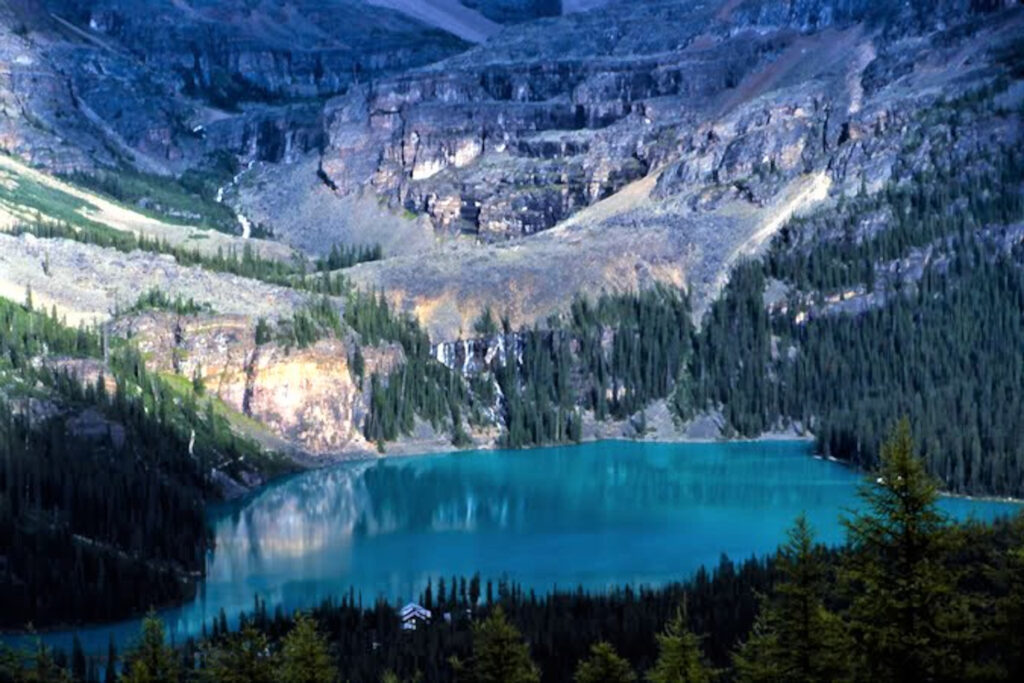
Nestled deep within the Canadian Rockies, O’Hara Lake in British Columbia is a pristine and breathtaking hidden gem that attracts nature enthusiasts, photographers, and hikers alike. Located in Yoho National Park, Lake O’Hara offers turquoise waters, dramatic alpine landscapes, and a sense of seclusion rarely found in such a popular park.

Location
O’Hara Lake is located in Yoho National Park, in southeastern British Columbia, Canada. It’s about a 2.5-hour drive from Calgary, Alberta, making it an accessible day trip or multi-day destination for those traveling through Banff or Lake Louise.
- Coordinates: 51.3582° N, 116.3346° W
Getting There
The access to Lake O’Hara is restricted to protect its fragile ecosystem, which adds to its exclusivity. Visitors cannot simply drive to the lake—it’s only accessible via a Parks Canada shuttle or by hiking.
- Shuttle Service: Reservations are required for the shuttle, and they fill up quickly. The shuttle departs from the Lake O’Hara parking lot (Yoho Valley Road) and takes about 15 minutes to reach the lake.
- Hiking: If you miss the shuttle, you can hike the 11 km (6.8 miles) access road to the lake. This hike takes around 2.5 to 3.5 hours depending on your pace, but it’s not the most scenic route compared to the many trails surrounding the lake.
Main Attractions
O’Hara Lake is famous for its clear, vibrant turquoise waters set against a backdrop of rugged mountain peaks. It’s a prime spot for hiking, photography, and nature exploration.
- Alpine Hiking Trails: The area surrounding the lake has some of the most stunning alpine hiking trails in Canada, ranging from short, easy walks to challenging day hikes.
- Lake O’Hara Alpine Circuit: A demanding 10.8 km loop that offers breathtaking views from above the lake. It’s known for its exposed ridgelines and views of Mount Victoria, Mount Lefroy, and Wiwaxy Peaks.
- Opabin Plateau: A moderate 5.9 km hike featuring stunning alpine meadows, lakes, and waterfalls, with a view of the lake from above.
- Lake McArthur Trail: A 7.5 km moderate hike with mesmerizing views of Lake McArthur’s deep blue waters.
- Wildlife Viewing: Visitors often spot mountain goats, marmots, and a variety of bird species. Keep your distance, but bring binoculars for a closer look.
- Photography: Sunrise and sunset at Lake O’Hara are magical, as the sunlight illuminates the surrounding peaks and reflects on the water. If you love capturing serene, postcard-worthy images, this is the place.

Elevation
Lake O’Hara sits at an elevation of approximately 2,020 meters (6,627 feet). The trails in the area can climb significantly higher, so be prepared for potential altitude effects if you venture on one of the steeper hikes.
Difficulty Level
The difficulty of hiking around Lake O’Hara varies depending on the trail:
- Easy: The shoreline trail around the lake is gentle and ideal for all fitness levels.
- Moderate to Difficult: Trails such as the Opabin Plateau and Lake McArthur offer moderate challenges, while the Alpine Circuit is more strenuous and suitable for experienced hikers.



Gear to Bring
- Hiking boots: Sturdy footwear is essential, especially if you plan on tackling the more difficult trails.
- Layered clothing: The weather can change quickly in the mountains. Bring waterproof layers and a warm jacket even in summer.
- Sun protection: Sunscreen, sunglasses, and a hat are essential due to the high elevation and exposure on some trails.
- Camera or binoculars: The views are stunning, and you’ll want to capture them.
- Food and water: There are no restaurants or stores at the lake, so pack a lunch and snacks. The water is clear but untreated, so consider bringing a water filter or purification tablets if you want to drink from streams.
Best Time to Visit
The Lake O’Hara area is only accessible in summer and early fall due to snow and avalanche risk during winter.
- Best Season: Late June to early September is ideal, with wildflowers in bloom and all the trails open. The autumn colors start to appear in September, offering a unique experience.
- Weather: Even in summer, temperatures can drop quickly in the mountains. Daytime highs can reach 20°C (68°F), while nighttime lows may dip below freezing.
Associated Costs
- Shuttle Fee: Approximately CAD $14 for a one-way ticket (prices can vary, so check Parks Canada for up-to-date information).
- Camping: The Lake O’Hara campground offers a unique wilderness experience but requires advanced booking through Parks Canada. Camping fees are around CAD $10 per person, per night.
- Accommodation: The Lake O’Hara Lodge is an exclusive, rustic lodge located right by the lake but comes with a high price tag. Alternatively, you can stay in nearby towns like Field or Lake Louise.
Challenges and Cautions
- Altitude: If you’re not accustomed to hiking at high elevations, take it slow and be mindful of altitude sickness symptoms like headaches or dizziness.
- Permits and Reservations: Due to its fragile environment, access to the lake is limited, and you need to book in advance, especially for the shuttle or accommodation.
- Wildlife: While it’s rare to encounter bears, carrying bear spray and making noise while hiking is advisable.
Final Thoughts
O’Hara Lake is a truly special place, offering a combination of tranquility, natural beauty, and adventure. Whether you’re a seasoned hiker looking for an alpine challenge or someone who simply wants to soak in the breathtaking views, this hidden gem is worth the effort. Due to its limited access and need for planning, it feels like an exclusive experience—one that will leave a lasting impression.
Make sure to book well in advance, prepare for varying conditions, and enjoy one of the most beautiful spots in the Canadian Rockies.






